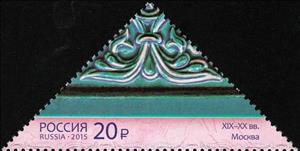Stamp: Ceramic tiles. Moscow. XIX-XX c. (Russia 2015)
Ceramic tiles. Moscow. XIX-XX c. (Russia 2015)
04 August (Russia ) within release Decorative and applied art of Russia goes into circulation Stamp Ceramic tiles. Moscow. XIX-XX c. face value 20 Russian ruble
| Stamp Ceramic tiles. Moscow. XIX-XX c. in catalogues | |
|---|---|
| Michel: | Mi: RU 2195 |
Stamp is horizontal format.
Also in the issue Decorative and applied art of Russia:
- Mini Sheet - Ceramic tiles. Moscow. XIX-XX c. face value 4*20;
- Mini Sheet - Ceramic tiles. Moscow region. Abramtsevo. XIX-XX c. face value 4*20;
- Mini Sheet - Ceramic tiles. Moscow region. Turygin. XXI c. face value 4*20;
- Mini Sheet - Ceramic tiles. Yaroslavl. XVII-XVIII c. face value 4*20;
- First Day Cover - Arts and crafts of Russia face value 80;
- First Day Cover - Arts and crafts of Russia face value 80;
- First Day Cover - Arts and crafts of Russia face value 80;
- First Day Cover - Arts and crafts of Russia face value 80;
- Stamp - Ceramic tiles. Yaroslavl. XVII-XVIII c. face value 20;
- Stamp - Ceramic tiles. Moscow region. Abramtsevo. XIX-XX c. face value 20;
- Stamp - Ceramic tiles. Moscow. XIX-XX c. face value 20;
- Stamp - Ceramic tiles. Moscow region. Turygin. XXI c. face value 20;
Stamp Ceramic tiles. Moscow. XIX-XX c. it reflects the thematic directions:
Art is a diverse range of human activities in creating visual, auditory or performing artifacts (artworks), expressing the author's imaginative or technical skill, intended to be appreciated for their beauty or emotional power. In their most general form these activities include the production of works of art, the criticism of art, the study of the history of art, and the aesthetic dissemination of art. The oldest documented forms of art are visual arts, which include creation of images or objects in fields including painting, sculpture, printmaking, photography, and other visual media. Architecture is often included as one of the visual arts; however, like the decorative arts, or advertising, it involves the creation of objects where the practical considerations of use are essential—in a way that they usually are not in a painting, for example. Music, theatre, film, dance, and other performing arts, as well as literature and other media such as interactive media, are included in a broader definition of art or the arts. Until the 17th century, art referred to any skill or mastery and was not differentiated from crafts or sciences. In modern usage after the 17th century, where aesthetic considerations are paramount, the fine arts are separated and distinguished from acquired skills in general, such as the decorative or applied arts.
A ceramic is any of the various hard, brittle, heat-resistant, and corrosion-resistant materials made by shaping and then firing an inorganic, nonmetallic material, such as clay, at a high temperature. Common examples are earthenware, porcelain, and brick.
The Kionga Triangle (German: Kionga-Dreieck, Portuguese: Triângulo de Quionga) was a small region of German East Africa situated at the mouth of the Ruvuma River. The Ruvuma served as the border between the German colony and Portuguese Mozambique, and the Kionga Triangle was the only section of German East Africa south of the river. Its principal settlement was Kionga (now Quionga ) which had a population of 4,000 in 1910. It became a German possession in 1894 but came under Portuguese control in April 1916 during World War I. The post-war Treaty of Versailles reaffirmed that the river was the border between Tanganyika, then under British control, and Portuguese Mozambique. The triangle was the only territory that the treaty awarded to Portugal.


